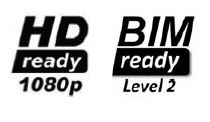Statistically, it is more than likely that you are reading this article in a digital form, whether online or in a downloaded .pdf. You may have found the article via Twitter, a newsletter or a blog referring to it as a source of information. We can be sure that the digital revolution is truly upon us and that the construction industry is still playing catch-up in this area, so says Anthony Harte, Director at James & WARD Ltd ![]() .
.
“ …the digital revolution is truly upon us and the construction industry is still playing catch-up…”
It’s fair to say that the TV and retail industries had a good head start in the digital age, with some of the biggest retailers collecting digital customer data for many years. Most sectors are now starting to take advantage of this digital era, and are using it to target marketing campaigns and promotions at the right time to the right people. But digital data within the retail sector only spreads as far as customer profiling, such as loyalty cards and online shopping habits. What about the construction and operational side of the buildings in which these businesses reside?
That’s where BIM comes in: the magical and mystical acronym which has caused such a stir in the last few years, particularly in the run-up to the Government’s April 2016 mandate. Whichever way you look at it, BIM is making itself known within the construction sector and has a lot in common with the Digital TV revolution. When HDTV first came about, many of us spent hours scratching our heads with questions such as: ‘Do we need HD Ready, HD 720, HD 1080p, HD 4k?’ And undoubtedly as end-users/customers, we initially had to pay a premium at the time for a better product and to be ahead of the game.
There are similar questions in the construction industry such as: ‘Do we need to be BIM Ready, BIM L2, BIM L3, BIM 6D, BIM LOD8?’ (Okay, so I made some of these up, but people often get these confused!).
In 2005, a licence agreement was introduced by Digital Europe who developed four labels or logos accrediting various features for Digital TVs. This agreement gives minimum requirements, testing and verification details, logo usage guidelines etc. and these still govern the terms under which you can use HD TV logos today. So what about the construction sector?
The HD TV guideline compliance logo (left) and an example of a possible compliance logo for BIM (right).
“Who can we turn to for a compliance check…?”
Before we can standardise and demonstrate compliance in the ‘BIM world’, we first need to have concise documentation that lists the standards required to meet the various ‘Levels’. Now some might argue that we do already have (or are close to having) these, but there are still many discrepancies and disagreements. Who can we turn to for a compliance check when the industry is still in dispute about what Level 2 means, never mind identifying which standards are compliant, due to the various discrepancies between documents? It’s great to see the standards being developed and updated, as most of the documents available today didn’t exist when we started our BIM Journey at James & WARD back in 2008.
“The NBS National BIM Library and NBS BIM Object Standard are a win-win for architects, manufacturers and the client…’’
When I first started working in BIM, one of the first complex objects/assets I had to build virtually was a KONE TM115 travellator for a retailer. At the time I told my boss (now co-director) that it only took me ‘a couple of hours’. It did in fact take me a whole day, but if the manufacturer had provided their content in a BIM-ready format, not only would I have saved my company a day’s work, but I could also have better spent that time elsewhere – actually designing, for instance! So as a result, the cost of having to produce this information is ultimately passed on to the client.
By working together with manufacturers and following the NBS BIM Object Standard, we only need to create objects once. This increases accuracy at every stage of the build and achieves substantial savings in terms of lifecycle costs, not to mention allowing the designers to do what they do best, and helping manufacturers sell more products.
What’s not to like?
Structured data has a massive role in BIM, and by following set standards we are establishing the foundations for managing this data now and in the future. The NBS BIM Object Standard and the NBS National BIM Library host manufacturers’ information to agreed set standards with suitable levels of useful data and information attached.
To summarise, the industry needs structured, approved, trusted content and useful data to start laying the foundations for our future generations. It’s thanks to NBS with their investment in the NBS BIM Object Standard, the NBS National BIM Library, integrated specification tools and the NBS BIM Toolkit that the industry is finally starting to achieve this. The future will see building operators harvesting the facilities management and lifecycle data from our operational buildings. This in turn will provide real-time feedback from our built assets, enabling predictive decisions and giving us a greater understanding of the performance we can expect from our virtual models. It’s important that we remember how the data we capture today influences the specification of tomorrow.
“ Harvesting FM data and real time feedback will reduce lifecycle costs.”
That future is now.
This article features in the National BIM Report for Manufacturers 2016. You can download your full, free copy of the report (.pdf, 3.19Mb) which includes comprehensive analysis of this years' findings alongside specialist insight and case studies focussed on real-world BIM implementation. Articles from the report also feature on theNBS.com.
Related articles on theNBS.com
The digital construction revolution: When will BIM become BAU?
The pace of technological change won’t let up so needs to be embraced. While other industries may have made the digital leap earlier, the construction revolution is now well underway. We look at the road ahead as roles and disciplines blur to the role of a new generation of digital natives to whom BIM will just be business as usual.




